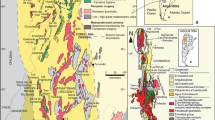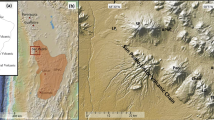Abstract
Jeju Island comprises extensive lava flows and hundreds of monogenetic volcanic cones with rare and thin sedimentary deposits. However, a number of boreholes reveal that the lavas are only 50 to 120 m thick along the coastal regions and are underlain by a 100 m-thick volcaniclastic sedimentary formation, which is correlative with the Seoguipo Formation. Detailed examination of the subsurface Seoguipo Formation, as recovered from the Sagye borehole in the southwestern part of the island, reveals that the formation consists of primary hydrovolcanic facies (massive or inclined stratified lapilli tuff) emplaced by Surtseyan fallouts and debris flows in subaerial or subaqueous settings and reworked hydrovolcanic facies (stratified, massive, or normally graded pebble conglomerate and sandstone) and nonvolcanic facies (homogenous or laminated mudstone) that were deposited in subaerial to submarine (nearshore to offshore) settings. The predominance of volcaniclastic deposits in the formation demonstrates that the early stage of Jeju volcanism was characterized by repetitive hydrovolcanic activity probably because of an abundance of external water for hydroexplosion. The Seoguipo Formation is envisaged to consist of multiple, superposed hydromagmatic volcanoes with intervening, marine or nonmarine sedimentary sequences. This finding warrants redefinition of the Seoguipo Formation as a sedimentary succession, above the U Formation, composed of fossil-barren and and fossiliferous, subaerial and subaqueous, volcaniclastic and nonvolcanic sedimentary deposits beneath the plateauforming lavas.
Similar content being viewed by others
References
Choi, K.S. and Park, Y.A., 2000, Late Pleistocene silty tidal rhythmites in the macrotidal flat between Youngjong and Yongyou Islands, west coast of Korea. Marine Geology, 167, 231–241.
Chough, S.K. and Sohn, Y.K., 1990, Depositional mechanics and sequences of base surges, Songaksan tuff ring, Cheju Island, Korea. Sedimentology, 37, 1115–1135.
Clifton, H.E., Hunter, R.E. and Phillips, R.L., 1971, Depositional structures and processes in the non-barred high-energy nearshore. Journal of Sedimentary Petrology, 41, 651–670.
Haraguchi, K., 1931, Geology of Cheju Island. Bulletin of Geological Survey of Korea, 10, 1–34.
Heiken, G. and Wohletz, K., 1985, Volcanic Ash. Berkeley, University of California Press, 246 p.
Jennette, D.C. and Pryor, W.A., 1993, Cyclic alternation of proximal and distal storm facies: Kope and Fairview Formations (Upper Ordovician), Ohio and Kentucky. Journal of Sedimentary Petrology, 63, 183–203.
Kang, S., Jung, K.K. and Yoon, S., 1999, Benthic foraminiferal fauna from the Seoguipo Formation of Cheju Island, Korea. Journal of Paleontological Society of Korea, 15, 95–108.
Kelling, G. and Mullin, P.R., 1975, Graded limestones and limestonequartzite couplets: possible storm deposits from Moroccan Carboniferous. Sedimentary Geology, 13, 161–190.
Khim, B.K., Woo, K.S. and Sohn, Y.K., 2001, Sr isotopes of the Seoguipo Formation (Korea) and their application to geologic age. Journal of Asian Earth Sciences, 19, 701–711.
Khim, B.K., Woo, K.S. and Yoon, S.H., 2000, Comparison of oxygen isotope profile of a fossil bivalve with the modern hydrographic condition: case study of the Seoguipo Formation (Korea). Geosciences Journal, 4, 15–24.
Kim, B.K., 1972, A stratigraphic and paleontologic study of the Seogwipo Formation. The Memoir for Prof. Chi Moo Son's Sixtieth Birthday, 167–187.
Kim, J.-Y. and Heo, W.-H., 1997, Shell beds and trace fossils of the Seogwipo Formation (Early Pleistocene), Jeju Island, Korea. Ichnos, 5, 89–99.
Kim, K.H., Tanaka, T., Nakamura, T., Nagao, K., Youn, J.S., Kim, K.R. and Yun, M.Y., 1999, Paleoclimatic and chronostratigraphic interpretations from strontium, carbon and oxygen isotopic ratios in molluscan fossils of Quaternary Seoguipo and Shinyangri Formations, Cheju Island, Korea. Palaeogeography, Palaeoclimatology, and Palaeoecology, 154, 219–235.
Koh, G.W., 1997, Characteristics of the groundwater and hydrogeologic implications of the Seoguipo Formation in Cheju Island. (unpublished Ph.D. thesis), Pusan National University, Pusan, 326 p.
Kokelaar, B., 1983, The mechanism of surtseyan volcanism. Journal of the Geological Society, London, 140, 939–944.
Kokelaar, P., 1986, Magma-water interactions in subaqueous and emergent basaltic volcanism. Bulletin of Volcanology, 48, 275–289.
Leat, P.T. and Thompson, R.N., 1988, Miocene hydrovolcanism in NW Colorado, USA, fuelled by explosive mixing of basaltic magma and wet unconsolidated sediment. Bulletin of Volcanology, 50, 229–243.
Lee, D.Y., Yun, S.K., Kim, J.Y. and Kim, Y.J., 1988, Quaternary geology of the Jeju Island. Taejon, Korea Institute of Energy and Resources, KR-87-29, 233–278.
Lee, M.W., 1982, Petrology and geochemistry of jeju volcanic Island, Korea. Science Reports of the Tohoku University, 15, 177–256.
Lee, M.W., Won, C.K., Lee, D.Y. and Park, G.H., 1994, Stratigraphy and petrology of volcanic rocks in southern Cheju Island, Korea. Journal of Geological Society of Korea, 30, 521–541.
Li, B., Park, B.K., Kim, D.S. and Woo, H.J., 1999, The geologic age and paleoenvironment of the lower Seoguipo Formation, Cheju Island, Korea. Geosciences Journal, 3, 181–190.
Mylow, P.M. and Southard, J.B., 1991, Combined-flow model for vertical stratification sequences in shallow marine storm-deposited beds. Journal of Sedimentary Petrology, 61, 202–210.
Oh, J.Y., Yi, S., Yoon, S., Koh, G.W., Yun, H. and Lee, J.D., 2000, Subsurface stratigraphy of Jeju Island. Journal of Geological Society of Korea, 36, 181–194.
Park, J.B., 1994, Geochemical evolution of the Cheju Volcanic Island, Korea. (unpublished Ph.D. thesis), Yonsei University, Seoul, 303 p.
Park, K.H., Cho, D.L. and Kim, J.C., 2000a. Geological report of the Moseulpo-Hanlim sheet (1∶50,000). Korea Institute of Geology, Mining and Materials, Taejon, 56 p.
Park, K.H., Cho, D.L., Kim, Y.B., Kim, J.C., Cho, B.W., Jang, Y.N., Lee, B.J., Lee, S.R., Son, B.K., Cheon, H.Y., Lee, H.Y. and Kim, Y.U., 2000b, Geologic report of the Seogwipo-Hahyori Sheet (1∶50,000). Jeju Provincial Government, 163 p.
Park, K.H., Song, K.Y., Hwang, J.H., Lee, B.J., Cho, D.L., Kim, J.C., Cho, B.W., Kim, Y.B., Choi, P.Y., Lee, S.R. and Choi, H.I., 1998, Geological report of the Cheju-Aewol sheet (1∶50,000). Cheju Provincial Government, 290 p.
Ross, G.M., 1986, Eruptive style and construction of shallow marine mafic tuff cones in the Narakay Volcanic Complex (Proterozoic, Hornby Bay Group, Northwest Territories, Canada). Journal of Volcanology and Geothermal Research, 27, 265–297.
Shanmugam, G., 1996, High-density turbidity currents: are they sandy debris flows?. Journal of Sedimentary Research, 66, 2–10.
Sohn, Y.K., 1995, Structures and sequences of the Yongmeori tuff ring, Cheju Island, Korea: Sequential deposition from shifting vents. Journal of Geological Society of Korea, 31, 57–71.
Sohn, Y.K., 1996, Hydrovolcanic processes forming basaltic tuff rings and cones on Cheju Island, Korea. Geological Society of America Bulletin, 108, 1199–1211.
Sohn, Y.K., 2002, A dynamic feedback between volcanism and stratigraphy: II. Hydrovolcanism and Quaternary depositional records on Jeju Island, Korea. Eos Trans. AGU, 83(22), Western Pacific Geophysics Meeting, Wellington, July 9–12, Abstract SE51B-05.
Sohn, Y.K. and Chough, S.K., 1989, Depositional processes of the Suwolbong tuff ring, Cheju Island (Korea). Sedimentology, 36, 837–855.
Sohn, Y.K. and Chough, S.K., 1992, The Ilchulbong tuff cone, Cheju Island, South Korea: depositional processes and evolution of an emergent, Surtseyan-type tuff cone. Sedimentology, 39, 523–544.
Sohn, Y.K. and Chough, S.K., 1993, The Udo tuff cone, Cheju Island, South Korea: transformation of pyroclastic fall into debris fall and grain flow on a steep volcanic cone slope. Sedimentology, 40, 769–786.
Sohn, Y.K., Park, J.B., Khim, B.K., Park, K.H. and Koh, G.W., 2002, Stratigraphy, petrochemistry and Quaternary depositional record of the Songaksan tuff ring, Jeju Island, Korea. Journal of Volcanology and Geothermal Research, 19, 1–20.
Tamanyu, S., 1990, The K−Ar ages and their stratigraphic interpretation of the Cheju Island volcanics, Korea. Bulletin of Geological Survey of Japan, 41, 527–537.
Tessier, B., Archer, A.W., Lanier, W.P. and Feldman, H.R., 1995, Comparison of ancient tidal rhythmites (Carnoniferous of Kansas and Indiana, USA) with modern analogues (the Bay of Mont-Saint-Michel, France), In: Flemming, B.W. and Bartholorna, A. (eds.), Tidal Signatures in Modern and Ancient Sediments. IAS Special Publication 24, p. 259–271.
Thorarinsson, S., 1967, Surtsey: The New Island in the North Atlantic. New York, The Viking Press, Inc., 47 p.
Walker, R.G. and Plint, A.G., 1992, Wave- and storm-dominated shallow marine systems, In: James, N.P. (ed.), Facies Models: Response to Sea Level Change. Geological Association of Canada, p. 219–238.
White, J.D.L., 1996, Pre-emergent construction of a lacustrine basaltic volcano, Pahvant Butte, Utah (USA). Bulletin of Volcanology, 58, 249–262.
White, J.D.L., 2000, Subaqueous eruption-fed density currents and their deposits. Precambrian Research, 101, 87–109.
Won, J.K., 1975, Study of geologic development and the volcanic activity of the Jeju Island. Science Report of Konkuk University, 1, 7–48.
Won, J.K., Matsuda, J., Nagao, K., Kim, K.H. and Lee, M.W., 1986, Paleomagnetism and radiometric age of trachytes in Jeju Island, Korea. Journal of Korean Institute of Mining Geology, 19, 25–33.
Woo, K.S., Cheong, D.K. and Park, B.K., 1995, Paleoceanographic investigation from the calcareous skeletons of the Pleistocene Seoguipo Formation, Cheju Island, Korea. Journal of the Korean Society of Oceanography, 30, 216–226.
Yi, S., Yun, H. and Yoon, S., 1998, Calcareous nannoplankton from the Seoguipo Formation of Cheju Island, Korea and its paleoceanographic implications. Paleontological Research, 2, 253–265.
Yokoyama, M., 1923, On some fossil shells from the island of Saishu in the Strait of Tsushima. Journal of College of Sciences, Tokyo Imperial University, 44, 1–9.
Yoon, S., 1988, The Seoguipo molluscan fauna of Jeju Island, Korea. Saito Ho-on Kai Special Publication, Japan, p. 539–545.
Yoon, S., 1997, Miocene-Pleistocene volcanism and tectonics in southern Korea and their relationship to the opening of the Japan Sea. Tectonophysics, 281, 53–70.
Yoon, S.H., Sohn, Y.K. and Han, S.J., 1995, Marine and Volcaniclastic Sequences in Cheju Island, Korea. Field Excursion Guidebook, Third International Conference on Asian Marine Geology, 82 p.
Author information
Authors and Affiliations
Corresponding author
Rights and permissions
About this article
Cite this article
Kwan Sohn, Y., Park, K.H. Early-stage volcanism and sedimentation of Jeju Island revealed by the Sagye borehole, SW Jeju Island, Korea. Geosci J 8, 73–84 (2004). https://doi.org/10.1007/BF02910280
Received:
Accepted:
Issue Date:
DOI: https://doi.org/10.1007/BF02910280




